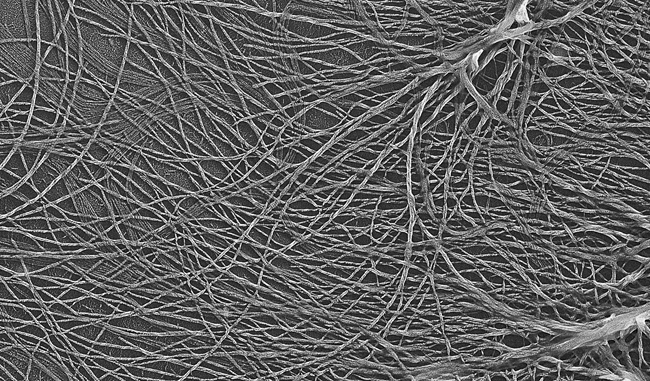Microscopic Fuzz May Be Best Evidence of Martians

If Martian life existed a few billion years ago, scientists think any plant-like microbes would have left behind a stringy fuzz of fibers.
That'sbecause here on Earth, researchers now say they have found such ancient fuzz,called cellulose, preserved in chunks of salt deposited more than 250million years ago ? making it the oldest biological substance yet recovered.The announcement comes about a week after a team of planetary scientistsannounced discovering evaporated saltdeposits on Mars and adds another element of hope to the search foralien life or signs of its past biology.
In fact,microscopic cellulose fibers might be one of the best signatures of any pastlife on the red planet, said Jack Griffith, a microbiologist at the University of North Carolina at Chapel Hill.
"Thesefibers are the oldest native, intact remnants of a living thing ever directlyobserved," Griffith told SPACE.com. "It's extremely fortuitoustiming, as we've just discovered salt deposits on Mars' surface."
PhilChristensen, a planetary geologist at Arizona State University who helpedidentify the Martian salt deposits and was not involved in Griffith's work,said the new fuzz finding piques his interest.
"Ifthe organic evidence of life's existence disappears at a site, it's hard to becertain anything was there," Christensen said. "I think findingcellulose in salt deposits on Earth makes an even stronger case for searchingfor life in Mars' salt deposits."
Griffithand his colleagues detail their salty cellulose discovery in the April issue ofthe journal Astrobiology.
Get the Space.com Newsletter
Breaking space news, the latest updates on rocket launches, skywatching events and more!
Built tolast
Until theteam's discovery, protein recovered from a 68 million-year-old Tyrannosaurusrex fossil owned the oldest-known biological material. The253-million-year-old cellulose fibers Griffith and others found are essentiallythe same stringy molecules that give wood its toughness.
?Celluloseis like the bacteria?s house, the biofilm surrounding them," Griffith said. "Plants adopted cellulose as their structural entity."
Heexplained that the samples found survived not only because of theirexceptional sturdiness, but also due to the salty environment: it killed offbacteria, preventing the cellulose from being chewed up as food.
"Cellulosefibers are just strings of glucose sugar molecules stuck together, end onend," Griffith said. "You can dissolve glucose, but as cellulose itresists some of the harshest chemicals and conditions out there."
He thinksthe micro fibers likely came from plant-like algae cells that thrived in a lakesimilar to Utah's Great Salt Lake.
"Thealgae may have deposited this stuff as the lake evaporated," he said,entombing it until the scientists dug it out of the Salado Formation ? anancient salt bed in New Mexico and nuclear waste repository ? and analyzed itunder an electron microscope. "It's very eerie down there. You get a realsense of how old the place is."
Saltysurprise?
If a futureMars-boundrobotic explorer seeks out signs of ancient life, Griffith said looking forcellulose in salt deposits peppered south of the planet's equator would be thebest places to start.
"Cellulosewas one of the earliest polymers organisms made during their evolution, so itpops out as the most likely thing you'd find on Mars, if you found anything atall," Griffith said. "Looking for it in salt deposits is probablya very good way to go."
Christensensaid Martian salt deposits likely formed after briny pools of water on theplanet's surface ? a sun-bathed environment for photo-synthesizing organismsthat may have made cellulose.
"Thesun is an awfully nice source of energy to turn down in your evolution as amicrobe," Christensen said. "If we do find signs of life on Mars, Iwouldn't be at all surprised if it is plant-like in nature."
MalcolmBrown Jr., a molecular biologist at University of Texas at Austin who hasstudied cellulose for decades, affirmed that such molecules could survive the test of time within salt.
"Ihave no doubt in my mind that it's possible, even after 3 billion years," Brown said, "just aslong as excessive heat or pressure didn't destroy the evidence."
- VIDEO: Looking For Life in All the Right Places
- VIDEO: Mars Reconnaissance Orbiter
- GALLERY: Ice on Mars
Join our Space Forums to keep talking space on the latest missions, night sky and more! And if you have a news tip, correction or comment, let us know at: community@space.com.
Dave Mosher is currently a public relations executive at AST SpaceMobile, which aims to bring mobile broadband internet access to the half of humanity that currently lacks it. Before joining AST SpaceMobile, he was a senior correspondent at Insider and the online director at Popular Science. He has written for several news outlets in addition to Live Science and Space.com, including: Wired.com, National Geographic News, Scientific American, Simons Foundation and Discover Magazine.









